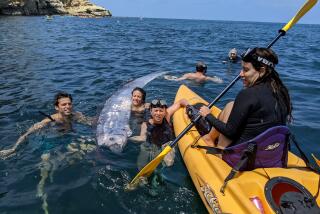Unusual parasite killing sea otters off California coast, scientists warn

- Share via
Four sea otters that washed ashore on the California coast died from an unusual parasite that scientists warn could possibly infect other marine wildlife and humans.
There are currently no known infections of the Toxoplasma gondii strain among humans, according to a study published Wednesday from the California Department of Fish and Wildlife and UC Davis.
But the microscopic parasite could infect any warm-blooded animal or find its way into the food chain, the study said. That includes marine animals like mussels, clams, oysters and crabs that are consumed raw or undercooked, corresponding study author Melissa Miller with the Department of Fish and Wildlife said in a written statement.
“I have studied Toxoplasma infections in sea otters for 25 years, and I have never seen such severe lesions or high parasite numbers,” Miller said of the dead otters. “We are reporting our preliminary findings to alert others about this concerning condition.”
Otters are especially susceptible to Toxoplasma infection, researchers said, because they find food along the shoreline and could be exposed to the parasite’s eggs in rainwater runoff as they feed on marine invertebrates. Typically, the parasite is found in wild and domestic cats and shed through their feces, according to the study authors.
The parasite strain, dubbed the COUG genotype, was first isolated in the wild from a mountain lion in Canada’s British Columbia during an investigation of the parasite’s outbreak in humans in 1995 and a feral pig in eastern California, according to the study authors. The Canadian government reported there were 110 acute human infections identified and none were fatal.
The COUG genotype was present in all four otters, the study said.
The first otter washed ashore in San Simeon in San Luis Obispo County in February 2020, according to the study. The adult female otter was still alive but thin and unresponsive. The other three otters washed ashore already dead from February through March 2022 in Cayucos in San Luis Obispo County and in Natural Bridges State Beach in Santa Cruz County, researchers said.
Numerous lesions were found throughout the nervous systems in the otters but were not found in the brain, which is typically one of the organs affected by the parasite, according to the study authors.
All four otters showed obvious signs of inflammation in their body fat, Miller said, and under the microscope, their tissue was flush with parasites, including faster-growing and actively multiplying invasive cells.
Otherwise, the otters were healthy adults that had no other severe disease, according to the study.
Typically, it takes time for the parasite to invade and multiply in the brain, but the sparse number of parasites in the brains of the four otters suggests the infection spread quickly, Miller said.
“We don’t know yet the interval between infection and death for this strain,” Miller said.
Study author Karen Shapiro with the UC Davis School of Veterinary Medicine said it was surprising to find the parasite in otters because it’d never been recorded in their species.
“So, finding this type [of Toxoplasma] in the marine environment was very unexpected, and particularly concerning given the rapid and virulent disease it caused in the four sea otters,” Shapiro said in an email.
In humans, the parasite can cause miscarriages and neurological disease, the study said.
The type of inflammation of the fat associated with toxoplasmosis has been reported in Hawaiian monk seals, according to Devinn Sinnott, a graduate student at UC Davis School of Veterinary Medicine. That strain has not been determined yet and is an active area of research in the UC Davis lab, Sinnott said in an email.
“We still have much to learn,” Sinnott said in a written statement that accompanied the study. “Larger-scale studies are needed to understand the potential impact of infection by the COUG Toxoplasma strain on sea otter populations, how geographically dispersed it is, how it is being introduced into the ocean and what other animals might be affected.”
More to Read
Sign up for Essential California
The most important California stories and recommendations in your inbox every morning.
You may occasionally receive promotional content from the Los Angeles Times.











